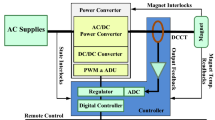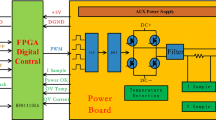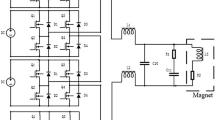Abstract
Purpose
The high energy photon source (HEPS) is the fourth-generation synchrotron photon source. Compared with the third-generation synchrotron photon source, the brightness is 100–1000 times higher, and the electron emittance of the storage ring is low to the diffraction limit of light. Through physical calculations, it is required that the stability of the storage ring quadrupole magnet power supply be better than 10 ppm, and the accuracy of output current be better than 80 ppm. This high demand for technical parameter poses a challenge to the development of high precision and stability power supplies.
Methods
The main circuit topology of the power supply adopts a phase-shifted full bridge soft switching scheme, which avoids interference caused by switching noise and improves power stability and efficiency. The high-precision digital power supply controller based on FPGA improves the sampling speed and control accuracy of the power supply, and the constant temperature control circuit ensures that the output current of the power supply meets the requirements of HEPS for power supply performance.
Results
In the batch testing section, a testing facility was built to test the stability, accuracy, repeatability, voltage ripple, and other parameter of high precision and stability power supplies. After a year and a half of testing, the performance tests of 1066 power supplies, including linear accelerators power supplies, booster power supplies, storage rings power supplies, dipole and quadrupole combined power supplies, dipole and quadrupole power supplies, were completed. The results all met and exceeded the design specifications.
Conclusions
The HEPS high precision and stability power supply meets the design requirements in terms of current stability, accuracy, repeatability, voltage ripple, and other aspects. The batch test results show that the power supply performance using the full bridge phase shifting soft switching technology combined with high-precision digital controller scheme is excellent, and the power supply consistency is good, providing a guarantee for the successful operation of HEPS in the future.
Similar content being viewed by others
Avoid common mistakes on your manuscript.
Introduction
Based on the power supply parameters, two power supply topologies were designed, with a total of 1066 power supplies. The power control adopts a self-developed digital power control module and combines it with an analog control chip to achieve full bridge phase shifting soft switching control. The controller adopts a constant temperature control circuit, effectively reducing current fluctuations caused by temperature changes. In terms of power structure, a 4U high case is selected as the main structure of the power supply, and a 19-inch rack is selected. To meet the requirements of batch testing, a batch testing facility has been established, which can simultaneously measure the stability of 25 power supplies, calibrate the coefficients of all power supplies, and complete repeatability testing and ripple testing. Finally, a comprehensive test was conducted on 1066 power supplies and statistics were conducted [1].
Main power circuit
The output current of the dipole and quadrupole combined power supplies, dipole and quadrupole power supplies is both unidirectional, and the output power of the power supply ranges from a few kilowatts to more than ten kilowatts. Therefore, adopting a full bridge topology can meet the requirements of high-power power supplies. In order to reduce the switching stress of the switch devices, reduce switching noise, and improve power efficiency, a phase shifting soft switch working mode is adopted. The output adopts a full-wave rectification circuit, and the filtering adopts an LC filter. Figure 1 shows power supply main circuit topology [2].
The internal structure of the power supply mainly adopts two designs. The 'tiled' design with IGBT acts as the main switching device and the 'modular' design with MOSFET as the main switching device [3]. The 'tiled' design has good heat dissipation, high utilization of internal space in the power supply, and is easy to maintain. The "modular" design has a compact structure, mainly consisting of PCB assembly, and the components are basically surface mounted, with high integration and suitable for manufacture. Among all high precision and stability power supplies, power above 10 kW adopts a "tiled" design, with a total of 202 units [4]. The power supply with a large number and low power adopts a "modular" design, with a total of 864 units. The two structural designs are shown in Fig. 2.
Power control scheme
The power control adopts a combination of digital control and analog control. In terms of loop control, a dual closed-loop control method of current and voltage is adopted [5]. The current outer loop is given and fed back by a digital power controller based on FPGA. The direct current–current transducer (DCCT) converts the output current in a ratio of 1000:1 and converts it into a voltage through a high-precision, low-temperature drift I/V conversion resistor. An 18-bit high-precision, high-speed AD chip is used for current acquisition. The calculation results of the outer current loop are accurately and quickly transferred to the voltage inner loop through high-precision DA. The voltage inner loop uses an analog chip UC3875 to achieve the control of full bridge phase shifting soft switching and the generation of PWM driving pulses. The control of analog chips increases the speed of the voltage loop and suppresses output voltage ripple. Figure 3 shows the power control block diagram.
The stability requirement of HEPS high precision and stability power supply is better than 10 ppm, and only relying on power filtering is difficult to meet the requirements. And the impact of temperature changes on ADC cannot be ignored and is a key factor. The analog-to-digital converter ADS8382 used by the controller is an 18 bit, fully differential bipolar ADC with a maximum sampling rate of 600 kHz. Every 1 °C change in external temperature will cause a voltage drift of 25 ppm in the internal reference source, which will cause significant changes in the AD sampling results and directly affect current stability. Therefore, the constant temperature control of ADC is crucial. In the design, a constant temperature control circuit is used to control the sampling module at 45 ℃, with a control accuracy of 0.1 ℃, minimizing the impact of ADC temperature drift on power supply performance. This is the key to achieving a 10 ppm power supply. Figure 4 shows constant temperature control of ADC.
Power supply and rack
The main specifications and quantity of HEPS high precision and stability power supply include 260A/45 V (200 units), 160A/20 V (153 units), 230A/25 V (710 units), and 3 other specifications of power supply. The power supply rack adopts a 19-inch-wide, 4U high, and 650-mm-deep iron chassis. The power cooling adopts a water-cooled structure. Use a touch screen for local operation and display.
The power rack is 2000 mm high, 800 mm wide, and 1000 mm deep. According to the location of HEPS magnets and the layout of the power hall, each rack can accommodate 5 power supplies. There is a height of 1U for placing the current sampling chassis. According to the location of the on-site power supply, the power load wire placed in the 8 power supply halls on the first floor of HEPS is led out from the top of the rack, while the power supply placed on the second-floor platform of HEPS is led out from the bottom of the rack. The rack has a main water inlet pipe that provides water distribution for 5 power supplies. Figure 5 shows the appearance of a high precision and stability power supply.
Power batch testing facilities
To meet the batch testing requirements of HEPS power supply, a testing facility has been built for comprehensive testing of power supply performance. These facilities have the ability to simultaneously measure 25 power supplies. The total distribution capacity is 400 kW, which can meet the full power operation of 25 sets of 260A/25 V power supplies simultaneously. We have customized 25 high-power resistance boxes made of Constantan (6J40) and placed them outdoors. Each load circuit is equipped with a standard DCCT sensor and corresponding power supply, as well as high-precision I/V conversion resistors, for various performance tests of the power supply. Using 3 KEITHLEY 7 1/2 digital meters, each meter can measure 10 channels, meeting the stability and accuracy testing of 25 power supplies.
In terms of control, all power supplies can be connected to the switch through network interfaces, achieving network synchronization control. Therefore, through the network, remote control operations such as power on, off, and current up and down can be achieved for all power supplies, improving the efficiency of batch testing (Figs. 6, 7).
Power performance testing
The technical parameter of HEPS high precision and stability power supply is shown in Table 1. All performance and parameter in the power supply test must meet technical requirements. The testing process adopts the overall testing of the power supply and rack, while measuring whether the performance of the power supply, DCCT, and rack meets the standards. The testing process also requires completing the coefficient calibration of the power supply and continuous work for 72 h. Table 1 shows the technical parameter of HEPS high precision and stability power supply.
The calculation formulas for stability, accuracy, and repeatability are shown in Table 2.
The stability test mainly tests the average of the output current of the power supply after continuous operation for 8 h. The stability curves of the 260A/45 V and 230A/25 V power supplies tested at 80% of output are shown in the following figure. After calculation, the stability is 5.22 ppm and 6.39 ppm, respectively (Fig. 8).
Accuracy is the measurement of the error between the actual output current and the given current. The actual output current needs to be calibrated before it can be compared. Use standard sensors to calibrate the ADC and feedback sensor coefficients of the power supply, and replace the original ADC sampling coefficients with the calculated "slope" and "intercept" to reduce the output current error, so that the error between the actual current value and the given current value is within a certain range (Table 3).
Repeatability testing mainly measures the consistency of the output current of the power supply at different intervals of time. Firstly, measure the average output current for a fixed period of time (30 min), then turn off the machine, and hold for 30 min. Set the current again to the same current value as before, and calculate the average of the two currents to obtain repetitive data (Table 4).
The voltage ripple test is to directly observe the high-frequency and low-frequency ripple of the output voltage with an oscilloscope, and obtain the effective value of the ripple voltage through Fourier analysis. We tested the low-frequency and high-frequency ripple of the output voltage of 260A/45 V and 230A/25 V power supplies under 80% load (Fig. 9).
Test data statistics
The stability, accuracy, repeatability, and voltage ripple distribution of all tested power sources are shown in the figure. All data tested at 80% rated current (Fig. 10).
References
100 million times brighter than a light bulb, 1 trillion times brighter than the sun! This is the light it emits [EB/OL]. https://mp.weixin.qq.com/s/2gX3-tu5-ajU4uYY32OPYA. (in Chinese)
X.M. Jiang, J.Q. Wang, Q. Qin et al., Chinese high energy photon source and the test facility. Scientia Sinica Physica Mechanica Astronomica 44(10), 1075–1094 (2014). (in Chinese)
X. Guo, P. Liu, C. Han, B. Chen. Development of high precision and stability DC power supply prototype for high energy photon source. Atomic Energy Sci. Technol. (in Chinese)
F. Long, J. Cheng, Design of a digital regulator based on field programmable gate array. Atomic Energy Sci. Technol. 43(9), 780–784 (2009). (in Chinese)
P. Liu, F. Long, A precision ADC sampling system design. Radiat. Detect. Technol. Methods 4, 182–189 (2020)
Author information
Authors and Affiliations
Corresponding author
Ethics declarations
Conflict of interest
On behalf of all authors, the corresponding author states that there is no conflict of interest.
Rights and permissions
Springer Nature or its licensor (e.g. a society or other partner) holds exclusive rights to this article under a publishing agreement with the author(s) or other rightsholder(s); author self-archiving of the accepted manuscript version of this article is solely governed by the terms of such publishing agreement and applicable law.
About this article
Cite this article
Li, Y., Chen, S., Liu, Y. et al. Development and testing of high precision and stability power supply for high energy photon source. Radiat Detect Technol Methods 8, 1280–1285 (2024). https://doi.org/10.1007/s41605-023-00446-5
Received:
Revised:
Accepted:
Published:
Issue Date:
DOI: https://doi.org/10.1007/s41605-023-00446-5














